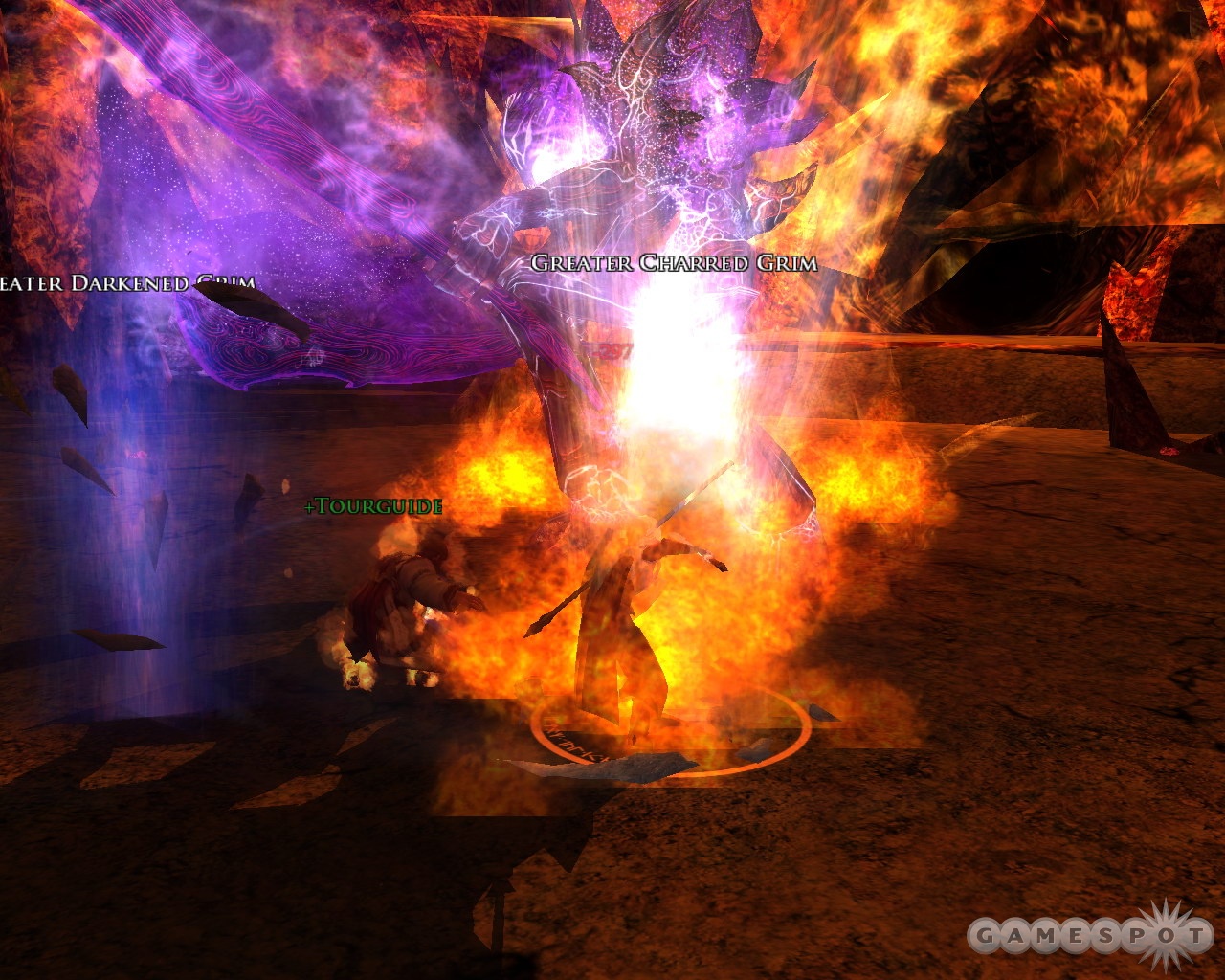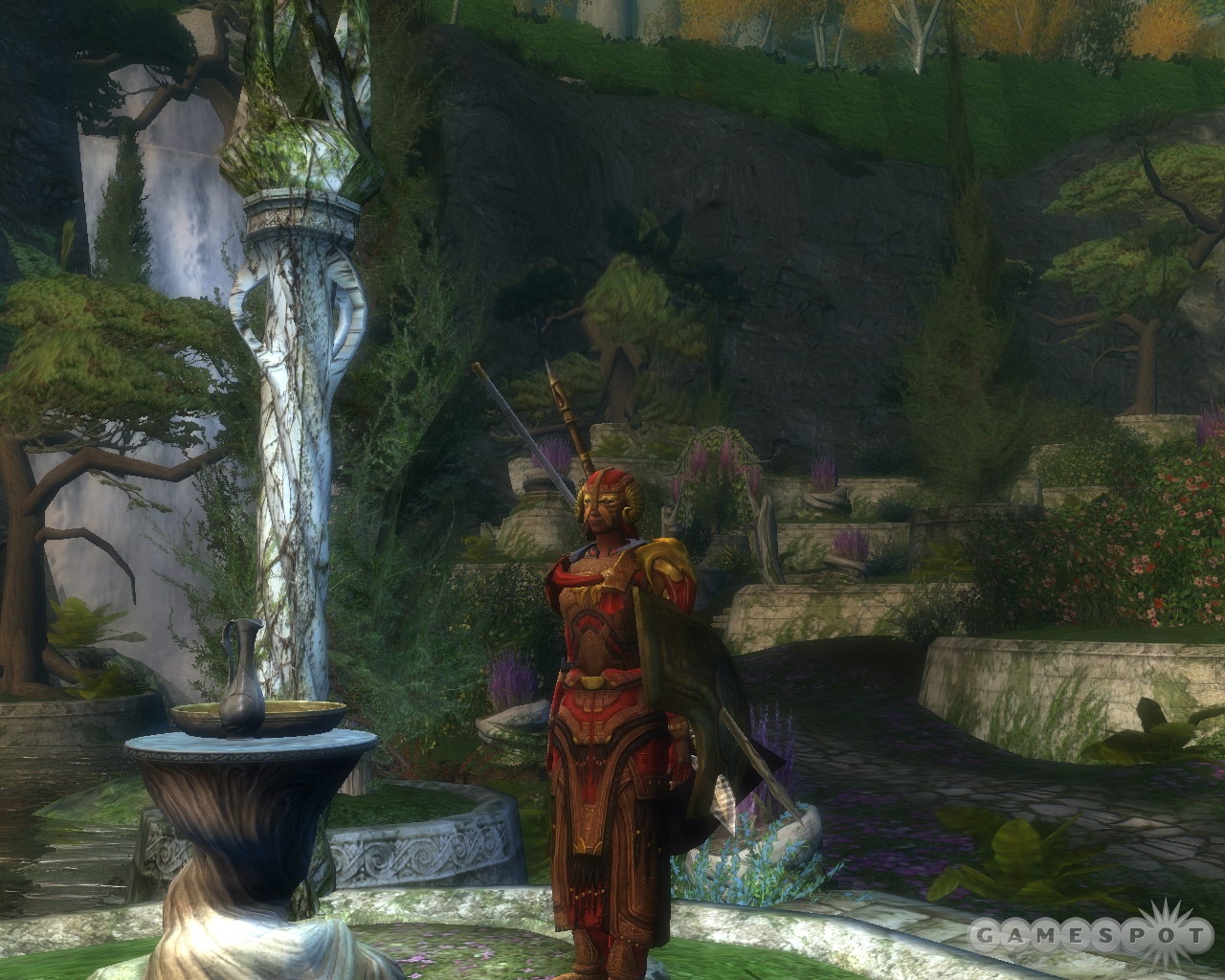When you first enter Moria, the famous dwarven depths, an imposing stairway of 1,001 rocky steps greets you. It's an indelible moment for Tolkien fans, but more importantly, it sets the stage for this curiously murky, moody expansion pack to last year's massively multiplayer The Lord of the Rings Online: Shadows of Angmar. With Mines of Moria, developer Turbine pulls off quite a feat: they make the tight labyrinths and cavernous halls of the mithril mines even more compelling to explore than the rolling hills of Middle-earth. Aside from a couple of new character classes, there's very little incentive for newcomers to join in, particularly given the thin population of the original environs. But for veterans, this is a treasure trove of rewarding questing and clever storytelling, and a must-buy for anyone with a character approaching level 50.
The mines aren't the only new area; you'll spend some time (perhaps a little too much during the slow-starting introductory story quest) in Eregion, and later in Lothlorien. Yet even in light of Lothlorien's glowing green spaces, Khazad-Dum is the most incredible region to behold, far surpassing what you would expect from what amounts to a gigantic underground dungeon. The environmental design is absolutely meticulous, and the corridors and hidden alcoves are at once ominous and inviting. You don't know what monster, what goblin encampment, what magnificent statue may be waiting around the bend, and it's this sense of unsettled wonder that will keep you peering around corners. However, the bleak sights don't just unfold in front of you, but also above and beneath you. One misstep may mean a heartrending plunge into a dark abyss or an inadvertent descent into an undiscovered area. Glance above for a look at impressive formations (natural and dwarven alike) that make for vistas that are at once spacious and eerily claustrophobic. The effective soundtrack ranges from the dramatic to the melancholy, dutifully enhancing the atmosphere.

These environs aren't just for show. The complex design of these areas also means you need to give thought to how you travel and how you fight. With the threat of a 300-foot plunge lingering a few footsteps away, root and fear abilities are as important as ever. And though there is a smattering of dwarven guides to help point you to nearby areas of interest, one of the greatest challenges is to figure out how to get from point A to point B alive. You may see your destination hovering above, but getting there might require fighting through glass spiders with your party or fending off orcs and their flaming arrows. Ensuing encounters are simply a lot of fun, even with just another player or two, thanks to thoughtful enemy placement and varied attack types. Even differing AI behaviors mix up the pace, with some creatures giving you a warning grunt before attacking you outright.
It's a wonderful marriage of content and art design that further strengthens the developer's knack for storytelling, a floundering art in most MMOGs, yet a triumph in Mines of Moria. Although some of the story chapters lack cleverness (gredbyg killing is better left to the nonessential questing), many of them shed light not only on the dwarves' attempt to reclaim their rightful territory, but also the origins of their plight. For example, in an early quest, you teleport to the past and watch the dwarves inadvertently release the fiery Balrog, and destroy a tenuous pact between themselves and the elves in the process. Its cinematic presentation and sense of real danger is a treat, and though much of the questing boils down to the usual fare, these special moments, and fantastic quest writing, will keep you emotionally involved.
Although there are some solo-focused quests like the one noted above, you'll want to grab a buddy or three and drag them along. The shadowed crevasses don't just look dangerous--they are dangerous, and general exploration has been clearly geared toward small fellowships. This was a smart choice; the small-party camaraderie fits well thematically, conjuring images of humans and hobbits huddled together for warmth as they eke their way to glory. But this focus on small groups also wisely pays heed to the diminished population of the game in general. Experienced adventurers looking to reach the new level cap of 60 will find plenty of questing partners during peak hours, but the original areas of the game are sparsely populated; if you're new to the game, or decide to roll a new character, you could play three or four hours before you run into other players, depending on your chosen race and profession.
Though Mines of Moria is not generally a solo-friendly experience, there are opportunities for you to keep yourself occupied when you're not in the socializing mood. There are numerous solo quests, some pitting you against fun bosses and requiring a good command of your abilities. However, the most intriguing way to spend your time outside a group is by creating and tweaking your own legendary weapons. The introductory quest to this feature is a bit tedious, but once you wade your way through, you will be grabbing legendary items off of fallen monsters. Then you can dismantle them, rejigger them, level them up, and even rename them. This flexibility is a welcome adjunct to the already-elastic traits and deeds system, but more importantly, you're not just forging a new sword, but an actual relationship with it. No longer is your weapon a disposable commodity; it's an extension of your virtual self. So powerful is this connection that you'll wish you could create legendary armor and accessories as well. Sadly, you can't dual-wield legendary melee weapons (though you can simultaneously equip, for example, a legendary bow and a legendary sword), but even in its current form, the customization possibilities will keep you constantly rethinking your character.

More flexibility is on tap within the two new character classes, the rune-keeper and the warden. Rune-keepers are essentially wizards, and they're a potentially troublesome addition for Lord of the Rings purists who would rather not see magic proliferate in this universe. Nevertheless, rune-keepers fill a spell-flinging need and are an absolutely proper compromise that favors fun gameplay over the strict tenets of Tolkien's prose--perfectly acceptable in a world where even the smallest details highlight the developer's reverence for the subject matter. Both new classes offer a wide range of gameplay possibilities. Wardens act as light tanks, stringing attacks together to create powerful finishing attacks called gambits; rune-keepers attune themselves to their chosen role as healer or offensive powerhouse. They are excellent classes, but without much in the way of new-player content and considering the low starting-area populations, they feel geared more toward existing players looking to try something new.
The unique player-versus-player component has seen some tweaks as well, such as new traits for monster players and a ten-llevel upgrade. Better support for smaller groups is also a wise change that is consistent with the other tweaks mentioned earlier, but clearly, Mines of Moria is focused more on storytelling than player battles. There aren't any major additions to PVP play, which is a shame, considering Wrath of the Lich King's newfound focus in this area and Warhammer Online's major inroads. The addition of the two new classes should make for some interesting battles in any case, though it remains to be seen whether that will be enough to breathe life back into the generally fun and exciting monster play.
The bowels of Middle-earth have no right to be this interesting to investigate, yet Moria's dim passages are a dungeon crawler's delight, surpassing even Shadows of Angmar's charming landscapes for sheer exploratory value. There isn't much for new players, though if you've avoided The Lord of the Rings Online until now, consider this: The expansion pack includes the original game, a value rare in MMOG expansions. Nevertheless, LOTRO veterans have the most to gain, thanks to awesome new areas, new story chapters to probe, and the giddy trepidation that comes with not knowing what ghoulish ogres might be lurking around the corner.